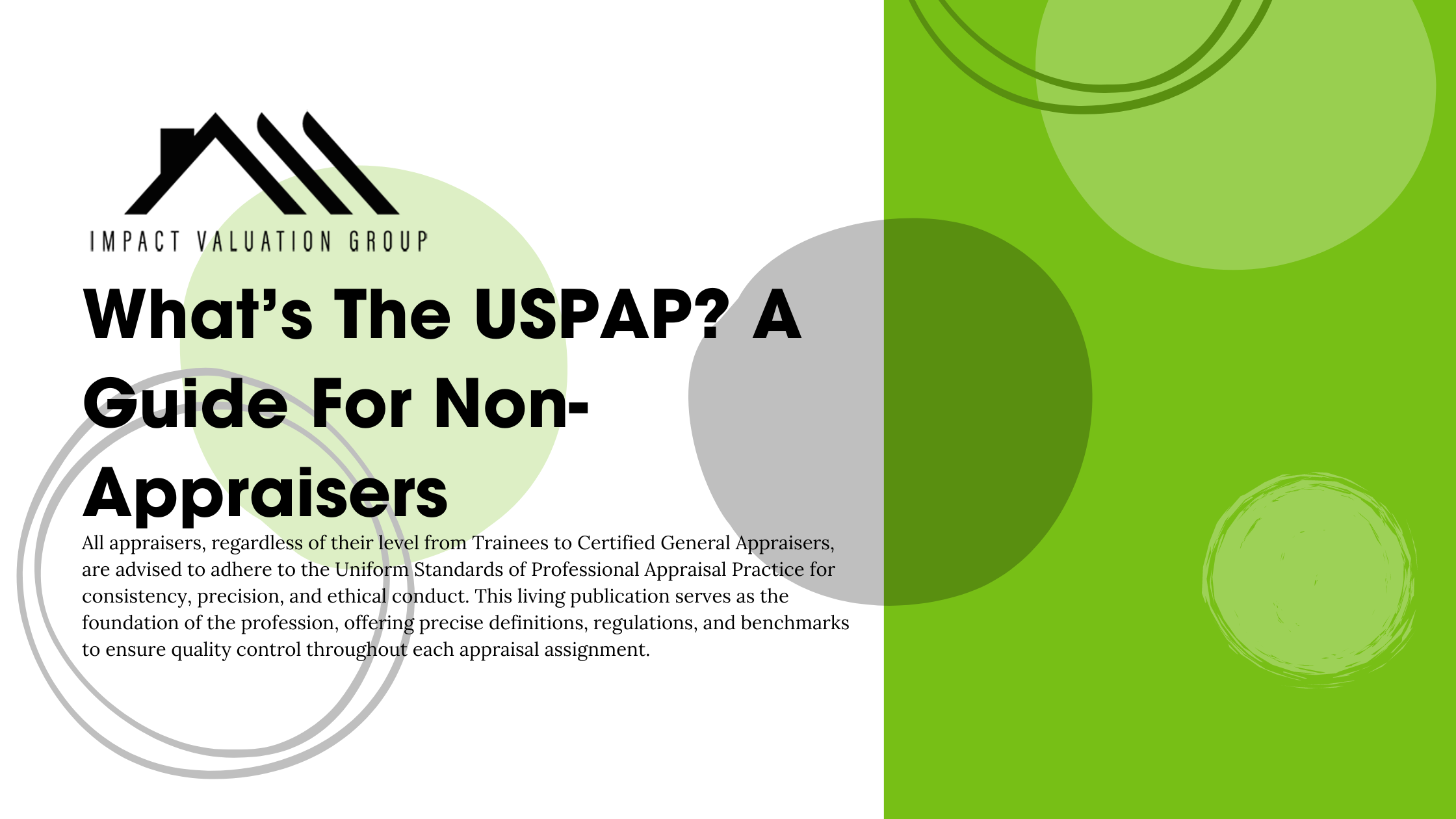What’s The USPAP? A Guide For Non-Appraisers
All appraisers, regardless of their level from Trainees to Certified General Appraisers, are required to adhere to the Uniform Standards of Professional Appraisal Practice (USPAP) for consistency, precision, and ethical conduct. This living publication serves as the foundation of the profession, offering precise definitions, regulations, and benchmarks to ensure quality control throughout each appraisal assignment.
IVG recognizes that these standards aren’t communicated to homeowners very well, and this can cause a lot of confusion, frustration, and sometimes even miscommunication! Keep reading to learn more about the standards appraisers have to follow before, during, and after your home appraisal.
What if appraisers don’t follow the USPAP?
The 5 Consequences of Violating The USPAP
This might seem like an out-of-order start to our blog for our homeowners out there, but it’s really important to understand that appraisers aren’t following the USPAP to be difficult, cruel, or to cause delays. There are real world consequences if their report or conduct is reviewed and found to have a violation or multiple violations.
Here is a glimpse at some of the consequences appraisers can face:
Loss of Public Trust: The public may lose confidence in the appraisal profession due to instances of inaccuracies or improprieties, leading to a significant impact on the credibility and reliability perceived within the industry's framework. Such erosion of trust can reverberate across various stakeholders, affecting the overall perception and functioning of appraisal practices.
Disciplinary Actions: Appraisers may face disciplinary actions from their state appraisal board, which can include verbal warnings, monetary fines, temporary suspension of their license, or in severe cases, the complete revocation of their appraisal license.
Legal Repercussions: Failure to adhere to the USPAP guidelines may result in legal consequences if it leads to substantial errors or misrepresentation in an appraisal report. Appraisers could face legal challenges or liabilities due to non-compliance.
Professional Isolation: Clients, such as lenders or financial institutions, may opt not to work with an appraiser in the future if they fail to meet the USPAP standards, leading to a loss of business opportunities and professional relationships.
Ethical Violations: Non-compliance with the USPAP's ethical standards can damage an appraiser's professional reputation and integrity. Such ethical violations can result in a loss of trust from clients and colleagues within the industry.
The USPAP Overview
WHO:
The USPAP Self-Introduction
The Uniform Standards of Professional Appraisal Practice was originally written in 1986-87 by an ad hoc committee representing various appraisal professional organizations in the U.S. and Canada. The copyright to USPAP was donated to The Appraisal Foundation (TAF) on April 27, 1987.
TAF, established in 1987 and based in Washington D.C., is a non-profit educational organization dedicated to fostering professionalism in valuation through the establishment and promotion of professional appraisal standards and appraiser qualifications. It was formed by these same groups, along with support and input from major industry and educational groups, and took over the administration of the USPAP.
The creation of the USPAP was largely in response to the U.S. savings and loan crisis of the 1970s and 1980s, and it was also the result of the growing need to unify appraiser standards across the profession. The Appraisal Standards Board (ASB), a division of TAF, maintains the USPAP and issues updates to ensure the standards evolve with changes in appraisal practice.
WHAT:
It’s a book!
Wait, it’s a magazine!
No…maybe it’s a scholastic journal!
It’s all of those things! It’s The USPAP in physical form! The Uniform Standards of Professional Appraisal Practice was adopted by Congress in 1989, USPAP includes standards for a wide range of appraisal services, such as real estate, personal property, business, and mass appraisals.
The USPAP aims to promote and maintain a high level of public trust in appraisal practice by establishing requirements for appraisers. It’s essential for appraisers to develop and communicate their analyses, opinions, and conclusions to intended users of their services in a manner that is meaningful and not misleading.
Compliance with the USPAP is required for state-licensed and state-certified appraisers involved in federally-related real estate transactions. To become a real property appraiser in the United States, appraisers must take specific courses for the USPAP and take updated courses every other year.
The physical cover of the USPAP.
WHY:
The Uniform Standards of Professional Appraisal Practice was created to establish a high level of public trust in appraisal practice by setting standards for ethical and performance standards in the United States. The need for USPAP arose from the collective efforts of professional appraisal organizations that recognized the importance of having a uniform set of standards to guide the profession.
The creation of the USPAP was a response to the savings and loan crisis of the 1980s, which highlighted the need for improved appraisal standards to protect the financial system. In 1986, an ad hoc committee formed by several professional appraisal organizations began drafting the USPAP to create and maintain these high levels of trust.
The USPAP was officially adopted by Congress in 1989 as part of the Financial Institutions Reform, Recovery, and Enforcement Act (FIRREA). This act recognized the USPAP as the generally accepted appraisal standards and mandated compliance for appraisers in federally-related transactions. The goal was to ensure that appraisals are performed with competence, impartiality, objectivity, and independence.
Getting a home appraisal doesn’t always mean it will come out they way you want it to, because trust us, we’d love for it to be that easy. The USPAP helps ensure that you’re receiving a fair, unbiased, and accurate home appraisal. Luckily, there is something you can do to avoid any surprises around closing if you’re a seller: get a pre-listing appraisal! Start your sale off with an attractive and fair listing price. Think of your pre-listing appraisal from the buyer’s point of view, it looks just as good as a pre-approved buyer! Yes, of course we offer this service! Click the button below to fill out the form for a free service quote. Even if we don’t serve your area, we’ll be happy to point you in the right direction!
IVG Fact Checker
About USPAP. (n.d.). Appraisers Association of America. https://appraisersassociation.org/education/uspap/about-uspap
Budd, K. (2023, March 13). Appraiser Disciplinary Levels and Their Consequences. Working RE Magazine. https://www.workingre.com/appraiser-disciplinary-levels-and-their-consequences/
Hess, PhD, L. (2013b, September 4). USPAP Q&A. Working RE Magazine. https://www.workingre.com/uspap-qa/
McKissock Learning. (n.d.). Understanding USPAP An Overview of the Uniform Standards of Professional Appraisal Practice. McKissock Learning. Retrieved May 2, 2024, from https://www.mckissock.com/appraisal/uspap/understanding-uspap/
The Appraisal Foundation. (2020). USPAP 2020-2021 Edition, The Appraisal Foundation 2020-2021 Uniform Standards of Professional Appraisal Practice (USPAP). The Appraisal Foundation. https://millersamuel.com/files/2021/03/USPAP-Standards-1-4.pdf (Original work published 2018)
The CE Shop Team. (n.d.). An In-Depth Look at the Uniform Standards of Professional Appraisal Practice (USPAP) [Review of An In-Depth Look at the Uniform Standards of Professional Appraisal Practice (USPAP)]. The CE Shop. Retrieved May 1, 2024, from https://www.theceshop.com/real-estate-appraisal/appraisal-essentials/guide-to-understanding-the-uspap
Uniform Standards of Professional Appraisal Practice (USPAP). (2019). Appraisalfoundation.org. https://www.appraisalfoundation.org/imis/TAF/Standards/Appraisal_Standards/Uniform_Standards_of_Professional_Appraisal_Practice/TAF/USPAP.aspx?hkey=a6420a67-dbfa-41b3-9878-fac35923d2af
Uniform Standards of Professional Appraisal Practice. (2023, March 19). Wikipedia. https://en.wikipedia.org/wiki/Uniform_Standards_of_Professional_Appraisal_Practice





